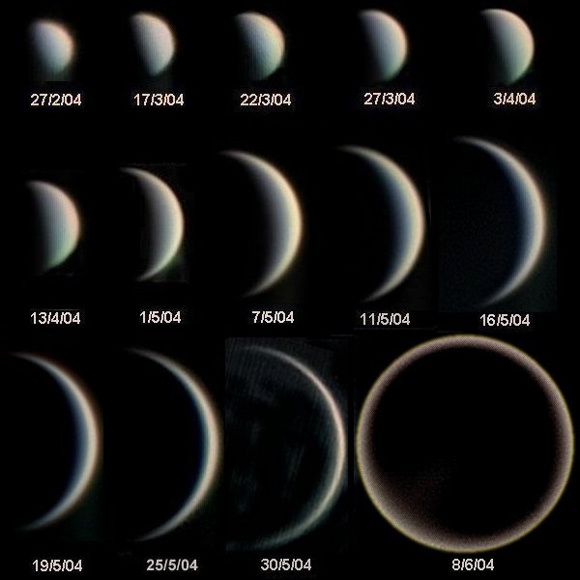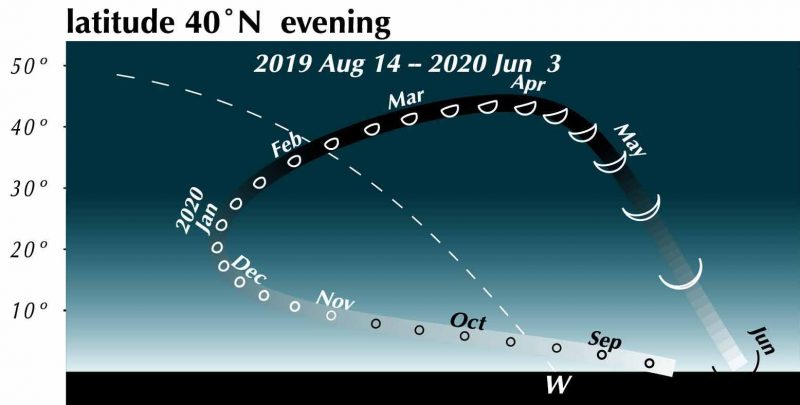
Venus in the Evening Sky from 2019 to 2020 from Larry Koehn on Vimeo.
EarthSky friend Larry Koehn of the great website shadowandsubstance.com created this animation. The video tracks a telescopic view of Venus, from when it reappeared in our evening sky around September-October 2019, all the way to May 2020. All animations are set for exactly 30 minutes after sunset. You can see some other planets coming and going in the evening sky, too. Thank you, Larry!
Did you know that Venus shows phases? Through a telescope, it can look like a tiny, featureless waning or waxing moon.
At this writing (late February 2020), Venus is in a waning gibbous phases. In other words, telescopic observers are seeing it as more than half lighted, but less than full.

This isn’t the moon. It’s the planet Venus as seen through the telescope. As Venus wanes in the evening sky it gets closer to Earth. The lit portion of Venus covers the greatest area of sky when its disk is about one-quarter illuminated. Image via Statis Kalyvas/ European Southern Observatory/ Wikimedia Commons.
Why does the phase of Venus change? It’s because this world orbits the sun on an orbit inside that of Earth’s. As a result, we sometimes see a fully lighted Venus: all of its day side. And we sometimes see just a gibbous or crescent Venus: just a sliver of its dayside.
Venus first entered the evening sky at full phase on August 14, 2019, a couple of months before people began spotting it. Then it was far across the solar system from us, and – if you could see it at all in the sun’s glare – you were seeing nearly all of its dayside.
Since then – as Venus has moved along in its smaller, faster orbit around the sun, preparing to pass between the Earth and sun in June of 2020 – Venus has been waning as seen from Earth. Around late March 2020, Venus will have passed its half-illuminated last quarter phase, and start to show itself as a waning crescent in our sky. Venus will shine most brightly as the evening “star” in late April/early May 2020. Paradoxically, it’ll be a crescent Venus shining so brightly; the brightness will stem from the planet’s nearness to Earth, as, by that time, Venus will be hot on Earth’s heels in orbit. Around late May and early June 2020, people with good vision might be able to see the crescent Venus with the eye alone.
Venus will pass between us and the sun, leaving our evening sky, on June 3, 2020. Then the planet will be at the new phase, with its sunlit side turned entirely away from us. It’ll be a waxing crescent Venus that reappears in the east before dawn a few days later.

View larger. | Venus officially entered the evening sky on August 14, 2019, and will officially leave it on June 3, 2020, the day upon which it’ll pass between us and the sun. This diagram shows the phase of Venus – visible through small telescopes – throughout this evening apparition. Chart via Guy Ottewell’s blog.
Bottom line: Video animation of the track of Venus (and other planets) from the time Venus became easily visible in the evening sky around September-October 2019 to May 2020.
Read more: EarthSky’s guide to the bright planets
from EarthSky https://ift.tt/2MAlVwf

Venus in the Evening Sky from 2019 to 2020 from Larry Koehn on Vimeo.
EarthSky friend Larry Koehn of the great website shadowandsubstance.com created this animation. The video tracks a telescopic view of Venus, from when it reappeared in our evening sky around September-October 2019, all the way to May 2020. All animations are set for exactly 30 minutes after sunset. You can see some other planets coming and going in the evening sky, too. Thank you, Larry!
Did you know that Venus shows phases? Through a telescope, it can look like a tiny, featureless waning or waxing moon.
At this writing (late February 2020), Venus is in a waning gibbous phases. In other words, telescopic observers are seeing it as more than half lighted, but less than full.

This isn’t the moon. It’s the planet Venus as seen through the telescope. As Venus wanes in the evening sky it gets closer to Earth. The lit portion of Venus covers the greatest area of sky when its disk is about one-quarter illuminated. Image via Statis Kalyvas/ European Southern Observatory/ Wikimedia Commons.
Why does the phase of Venus change? It’s because this world orbits the sun on an orbit inside that of Earth’s. As a result, we sometimes see a fully lighted Venus: all of its day side. And we sometimes see just a gibbous or crescent Venus: just a sliver of its dayside.
Venus first entered the evening sky at full phase on August 14, 2019, a couple of months before people began spotting it. Then it was far across the solar system from us, and – if you could see it at all in the sun’s glare – you were seeing nearly all of its dayside.
Since then – as Venus has moved along in its smaller, faster orbit around the sun, preparing to pass between the Earth and sun in June of 2020 – Venus has been waning as seen from Earth. Around late March 2020, Venus will have passed its half-illuminated last quarter phase, and start to show itself as a waning crescent in our sky. Venus will shine most brightly as the evening “star” in late April/early May 2020. Paradoxically, it’ll be a crescent Venus shining so brightly; the brightness will stem from the planet’s nearness to Earth, as, by that time, Venus will be hot on Earth’s heels in orbit. Around late May and early June 2020, people with good vision might be able to see the crescent Venus with the eye alone.
Venus will pass between us and the sun, leaving our evening sky, on June 3, 2020. Then the planet will be at the new phase, with its sunlit side turned entirely away from us. It’ll be a waxing crescent Venus that reappears in the east before dawn a few days later.

View larger. | Venus officially entered the evening sky on August 14, 2019, and will officially leave it on June 3, 2020, the day upon which it’ll pass between us and the sun. This diagram shows the phase of Venus – visible through small telescopes – throughout this evening apparition. Chart via Guy Ottewell’s blog.
Bottom line: Video animation of the track of Venus (and other planets) from the time Venus became easily visible in the evening sky around September-October 2019 to May 2020.
Read more: EarthSky’s guide to the bright planets
from EarthSky https://ift.tt/2MAlVwf

Aucun commentaire:
Enregistrer un commentaire